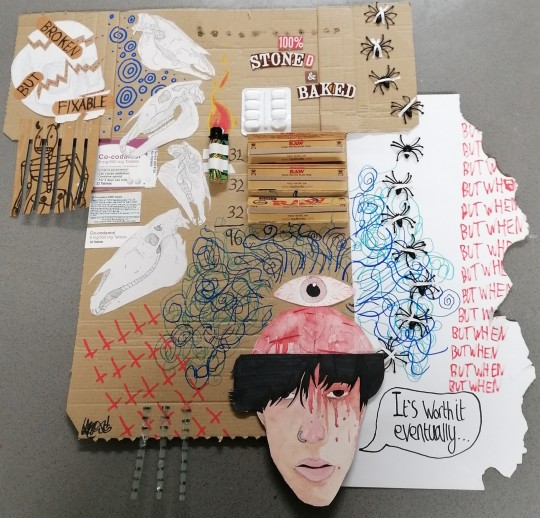Text
Artist Lecture - Hetain Patel
This lecture introduced the work of Hetain Patel to the class, Patel is an artist and filmmaker specialising mostly in video work. During the lecture Patel stated that his art is often politically motivated as he expressed a desire for his work to attempt to improve the quality of life for himself and others. During his youth Patel was subjected to racism which led to him feeling ashamed of his Indian heritage, this tearing of his cultural identity was reformed during his time in university allowing Patel to take back control of the culture he felt was robbed from him.
During the lecture Patel showcased many of his short films to us, my personal favourite were the three films:
“To Dance Like Your Dad” (2009) - A short film where Patel showcases a rehearsed copy of a video of his father working in his coach building factory. The mannerisms that Patels father displays are mimicked perfectly by Patel as he imitates the speech, movement and original camera work of the aforementioned footage. The film also displays the effect modern day late stage capitalism has on the population, as older people are forced to work in hard manual labour jobs for barely a living wage. I personally resonated with this film as my father has worked in manual labour for his entire life and although I have never been subjected to extreme poverty it is hard to see your dad come home exhausted from work most days. Patel touched on his relationship with his father through many of his films, viewing the time they spent working together as a “bonding experience.”
“The First Dance” (2012) - Another film that relies heavily on imitation of another's actions is Patels film “The First Dance.” In this film Patel's childhood dreams of kung-fu warriors inspired by the film “Crouching Tiger Hidden Dragon '' are brought to fruition in adulthood as he recreates a scene from the film performing a choreographed martial arts routine. Patel described the art of kung-fu becoming somewhat of a physical metaphor for hard labour and struggle, themes that he often attributed to be his true family heritage. Though well shot and excelentally choreographed I find it hard to resonate with this artwork as it is ultimately an imitation of someone else's choreography, I feel as though Patel could’ve gained a stronger message had he created an original routine that rivalled that of the film.
“Fiesta Transformer” (2013) - In a fantastic metaphoric display of working class labour Patel and his father joined together to create a model using his first car, a 1988 Ford Fiesta gifted to him by his father at the age of 17, despite the car used not being his original car the model is the exact same. The car represents the working class of Britain, adopting a squatting pose reminiscent of the way many working people chose to rest due to the lack of time they had whilst on their breaks. Patel stated that unlike the popular Transformer toys that inspired this artwork his aim was not to transform a powerful machine into a fearsome warrior, but to instead turn an affordable car into a standard human being. I would say that Patel succeeded in this goal as “Fiesta Transformer” is my personal favourite of all of his work. Having a background in manual labour myself I can say from first hand experience that squatting against a wall during any downtime you may have is a staple part of factory work.
In conclusion Patel expresses themes and ideas within his artwork that aim to tackle the current social climate we live in today, with the evil of capitalism affecting the very people that help keep it the ruling regime. As an artist who works with video a lot Patels work inspires me, allowing me to further my knowledge of video manipulation as a way to push a message you are passionate about.

0 notes
Text
“I Wanted my Third Eye Open but Holy Fuck”
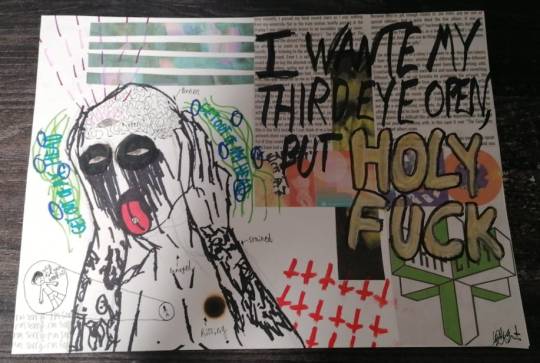
- “The Ghoul” 2021 (Acrylic Paint, Marker and Collage)
0 notes
Text
4D Project
youtube
“ADDICTION“
When creating my 4D project I instantly knew I wanted to make a video to showcase my editing ability as I have been editing videos since I was 12. The software I use today is Sony Vegas pro 18. I find this program gives me vast amounts of control over my projects compared to other editing softwares available today. When it came to picking a theme for my project I thought that a video portraying the harsh realities of addiction is what spoke to me the most. Being addicted to nicotine and struggling with a slight caffeine addiction too I was able to draw inspiration from my own experiences when creating the video. I shot my scenes late at night during Autumn as I wanted it to be ambiguous either night or early morning. My reasoning for doing so was I intended for the viewer to either interpret the act depicted in my video as the last thing I do before bed or the first thing I do when I wake up. I had the song “we've never met but, can we have a coffee or something?” by In Love With a Ghost playing in the background of my video, I chose this song because it had certain elements within the chimes of the music that allowed me to sync my videos along to it’s rhythm. Alongside this the song also provided the viewer with an underlying theme of sadness as the somber, melancholic melody seems to narrate the course of the video despite not having any vocals.
Once I had recorded all the footage I wanted to incorporate into my piece I began transferring them onto my computer and into Vegas Pro, I then began planning out the order I wanted to play each clip and synced their transitions to the rhythm of the song. I chose to add little snippets of text that read the words “ADDICTION” and “WE ARE HELPLESS” throughout the video in short intervals each time, the repetition of these words were to represent the repetition of each day when battling an addiction. I wanted to show how you can wake up each day begging yourself to make a different choice but always slipping back into that hole that is your addiction. I was feeling quite low when editing the videos and I feel as if that feeling of being drained can be felt throughout the short film, my facial expressions in the piece are low and neutral showing that I don’t even receive any comfort from the addiction anymore. I wanted to show the task in the video as a chore, something I didn’t really want to do but just had to get done.
At the end of the video I showcase some work I had created in my sketchbook, this was to represent how I longed for this feeling of needing to do something everyday to be applied to my artwork. Despite becoming a lot more devoted to my craft I have struggled with points of my life where I had no desire to create anything, during these lowest portions of my life I didn’t have a single thing I actually felt like I really wanted to do, every tasl felt like a chore. Now however with this video I am showing that the things that once gave me joy and allowed me to be calm feel unnecessary now. As I’m now at a point in my life that I am genuinely happy, accompanied by many factors that keep me motivated to work, these things I used to do to feel something other than nothing have now become no more than an everyday chore that must be fulfilled. Addiction is a very real problem and if anyone reading this is struggling themselves I want you to know that you can make changes if you put your mind to it, I am nowhere near “cured of my addiction” but the steps you can make to change are there and all we need to do is take that first step.
-“The Ghoul”
1 note
·
View note
Text
Artist Lecture - Mimi Hope
Mimi Hope is an artist from London whose vast amount of artistic exploration helped shape the artist she is today. She began painting with acrylic and oil paint from the age of 13 at the all girls school she attended before going on to attend a school for performing arts every weekend to explore her love of drama. She also spent time studying graphic design leading to Hope’s interest in conceptual art. As of today Hope’s main focus when it comes to her artistic expression is within 3D work and sculpture and their ability to generate themes of enlightenment whilst also instilling a sense of awe and wonder within the viewer. Hope displays an incredible work ethic that can be felt through her work as each piece is unique and easily recognisable. I personally feel Hope’s sculptures are able to provide the viewer with a powerful sense of serenity whilst also seeming soft and delicate in nature.
Hope has created works that comment on the themes of dreaming within this age of late stage capitalism that we live in. Her pieces that criticise the lottery system are some of my favourites, with Hope able to see the system for what it truly was; a mechanism employed by the government to instill a sense of hope for the working class whilst providing themselves with another financial scheme. I personally have always despised the lottery system and the way it leeches off the last remaining wealth of the working class under the guise of providing us with an opportunity to escape into the world of the elite. Despite being a member of a family that was lucky enough to overcome the seemingly impossible odds and win, it was not without countless money wasted on lottery tickets that were worthless.
Hope’s cloud pieces were also inspiring to me as I found their simplistic nature rather aesthetic and found myself encapsulated within the mystic beauty she is able to present. With multiple cloud pieces being made, titled by number, Hope provides us with many slightly different compositions of clouds. These pieces are lenticular prints which give the piece movement and synthesise the passage of time within an otherwise flat piece, however with the historical context regarding lenticular prints her works becomes a question on the consequences that late stage capitalist consumerism has had on the modern world.

1 note
·
View note
Text
Art in the City Lecture 6
In our sixth Art in the City lecture we focused on New York and the many artists that found success within the vast city. We also explored the rise of movements such as action painting and the diverse spread of cultures that populated New York at the time. Through an availability of affordable living spaces and art studios at the time many people were able to make a home for themselves within New York leading to a diverse selection of artistic works to have come out of the city. Being a major city in America New York was full of art galleries, museums and wealthy patrons who were looking for new pieces to purchase or fund, this allowed for artists to create and establish networks within the city leading their art to reach more potential viewers.
Despite all the benefits that the city provided to some however, there were also many people suffering from poverty. Due to issues such as racism, homophobia, sexism and classism, many groups of people were subjected to persecution and left unable to reap the benefits that were provided to the wealthier members of the city. Because of the discrimination these artists faced, many of their great works were unable to be presented within galleries, leading to a lack of recognition. However, through movements such as The Harlem Renaissance, an art movement that attempted to reclaim African American culture through artistic expression, the community was able to claim recognition for their work whilst becoming more in touch with the culture that was taken from them.
Marcel Duchamp
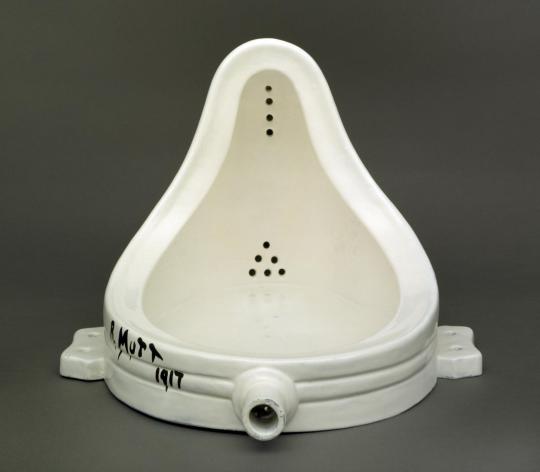
“Fountain” -1917 (Sculpture)
The piece “Fountain” was designed by Marcel Duchamp to question the very meaning behind art itself, to question what makes a piece “art” in the eyes of a viewer. By using his power within the newly established Society of Independent Artists, that he had gained by aiding with the founding and promotion of said society, Duchamp submitted a urinal he had purchased from a sanitary wares supplier signed with the alias “R. Mutt” Duchamp called the piece a “readymade” sculpture, meaning that it was not made for the intention of being a work of art, however the artist designates the piece as a work of art. The question presented by Duchamp can be asked of today's modern standards for artistic expression, with films and music often being made with the sole intention of making money rather than truly expressing one's innermost feelings.
Loïs Mailou Jones
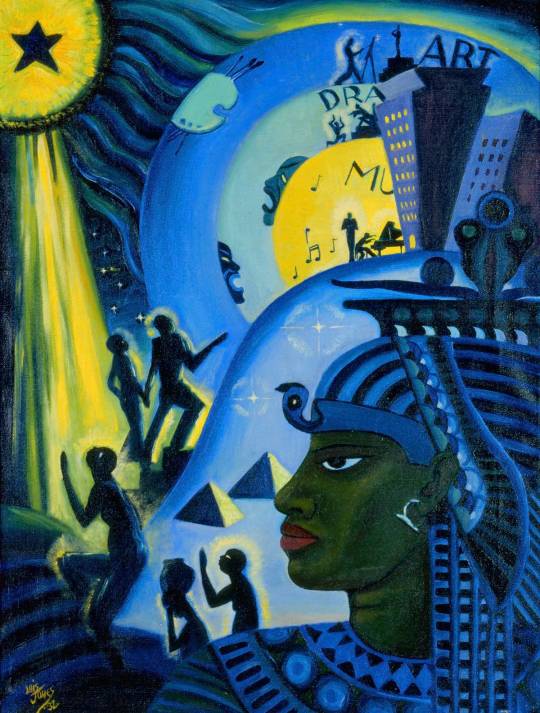
“The Ascent of Ethiopia” -1932 (oil on canvas)
Through the rising popularity of jazz and blues music within New York, African American people were able to express their cultural backgrounds and reclaim that which was lost to them. Jones’ piece “The Ascent of Ethiopia” presents the viewer with shadowed, sorrowful looking figures following the north star to a bright, colourful city radiating with artistic expression. In the foreground a pharaoh adorned in jewelry and clothing typical of royalty in ancient egypt overlooks the travelling people, their gaze sternly turned away from the modern city. This was Jones’ way of linking African American people with their past, whilst also looking forward towards their future. Though racism is still to this day an issue throughout the world through artistic expression we as a united planet can attempt to push back against the evils brought about by the past and those who wish to halt the rise of progression.
Edward Hopper
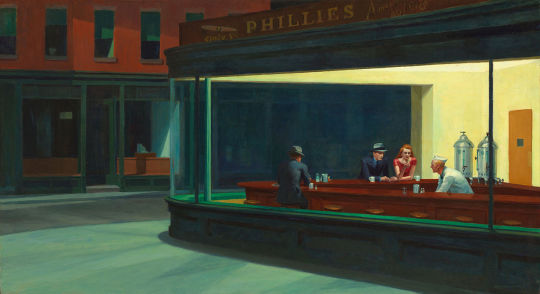
“Nighthawks“ -1942 (oil on canvas)
American Realism was an art movement that portrayed the normal lives of everyday working class people within America, by moving away from the romanticised motifs of the past artists were able to capture a glimpse of the world through the lens of the working class, a theme that was in itself romanticized by the rich elite. In Edward Hopper’s piece “Nighthawks” we see a bar painted ambiguously either at night or in the early hours of the morning due to the dim lighting on the street outside. Within the establishment are two men dressed in suits and a woman in a bright red dress, behind the bar the worker is seen hunched over presumably in conversation with the man and woman. This piece has many different ways it can be interpreted, due to the rising popularity of gangster movies at the time of creation the men can be viewed as either mobsters or detectives respectfully. The lack of information that is provided by the piece leaves the viewer forced to come up with their own imaginative scenario.
Jackson Pollock

“Convergence” -1952 (oil on canvas)
Convergence is one of Pollock's most famous works, the piece is what is called an action painting, a movement where artists used abstract means of applying their paint onto the canvas. In Pollock’s case he would lay his canvas on the ground, allowing him to move all around his work, splattering collages of vibrant colour across the giant canvas. His piece was born from a frustration that Pollock felt towards the constraints of society’s oppression, from breaking free of the constricting ideals that he felt forced upon the artistic community he was able to create a piece to embody his own ideals of freedom of speech and expression. Each colour can be seen as one of Pollock’s emotions unfolding onto the canvas, with the emptiness of the black being overshadowed by violent lashes of red overlaying the entire piece.
Kenneth Noland

“Drought” -1962 (acrylic paint on canvas)
“Drought” is one of many “target paintings” developed by Kenneth Noland, the narrower, less coherent borders of its bands leave “Drought” looking less target-like than the previous works. Noland’s theme of rotation can be seen through the piece's abstract spiral brushwork which seems to envelop and encircle the solid red and black in the centre of the piece. Though beautiful in design, I personally do not feel a connection to the theme of intensity Noland is attempting to present. Whilst I am able to grasp the beauty and artistic interpretation that others may find within “Drought” I do not connect to the intensity through rotation, instead I interpret the piece as a singular eye staring blankly at the viewer, pushing a theme of intensity through observation. This shows us how many pieces can be perceived despite the creators original intentions.
Mark Rothko

“Untitled” -1968 (synthetic polymer paint on paper)
Rothko was often widely regarded as one of America’s best painters, perfecting his style over two decades by experimenting with different ways to make the colours in his pieces “lock together.” The untitled piece we are presented with shows the amalgamation of warm colours mixed together to leave us with an abstract piece made up of basic shapes. Although Rothko’s design may look simple he often regarded that he spent hours working on each piece, apparently taking his time delicately making the colours fit together. Despite the warm, joyus emotion that can be felt from the bright colour pallet used in this piece I find it hard to truly appreciate it as I am not a fan of over simplistic designs within artistic expression.
Helen Frankenthaler

“New York Bamboo” -1957 (oil on unprimed canvas)
Helen Frankenthaler was an integral member of the second wave of Abstract Expressionists, she became famous for her experimentation with the materials she used to complete her pieces. She had developed a technique called “soak-straining” where Frankenthaler would apply washes of thinned paint onto a canvas that was not yet primed. This technique produced blotches of vivid colour that appeared to flow as if they were submerged in liquid, this abstract approach to creation led to her eventual success within the artistic community. Her piece “New York Bamboo” presents the viewer with heavy black streaks of paint forming what can be interpreted as luscious plantlife growing in front of lighter grey buildings. The ambiguous interpretations of Frankenthaler's pieces help add to the appeal of her work, allowing the viewer to ponder the meaning of the piece during their observation.
Lenore "Lee" Krasner
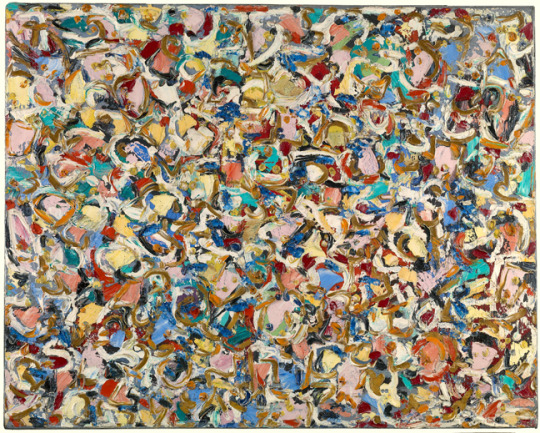
“Noon” -1947 (oil on linen)
Lee Krasner was an action painter who was once married to Jackson Pollock, due to their styles sharing a very similar look it is often debated who was the originator behind the action painting style. Like Pollock, Krasner would lay her canvas’ on the ground to maximise the space she was able to use during her pieces creation. “Noon” was part of her Little Image series that lasted from 1946 to 1950, with a total of 31 pieces in the series as a whole. “Noon” is an abstract collage of what can be perceived of tiny images all coming together to form the beautiful piece. I personally prefer Krasner's work to that of Jack Pollock as I have always felt that she has a more coherent style of her pieces, with more thought being put into the creation process. Whereas Pollock’s work can be interpreted as merely paint flicked at a canvas. Krasner didn’t receive the same fame and glory her former partner did due to the art world of her time being heavily male dominated, however she is now receiving the respect and recognition she deserves.
Norman Lewis

“Phantasy II” -1946 (oil on canvas)
Norman Lewis began his artistic ventures as a figurative painter, he often was inspired by the lifestyle in Harlem, looking to Jazz music to help fuel the abstract expressionist pieces. His art broke away from the stagnant, mundane pieces he felt littered the market at the time, oftentimes feeling as if traditional values were holding the artistic world back. Jazz music heavily inspired works such as “Phantasy II” with his boldly coloured lines mirroring the improvisational structure of most jazz songs, the piece also has an “urban” aesthetic to it helping to express that the world African American artists lived in was structurally and systematically different to others. Lewis’ work was important in establishing African American culture within the western media with his work inspiring jazz album covers to this day.
Andy Warhol

“Marilyn Monroe” -1967 (screenprint on paper)
Andy Warhol was an extremely inspirational American artist who specialised in capturing the themes of American capitalist consumerism in a pop art style. One of his most famous collections are the numerous work he did on the actress Marilyn Monroe, depicting her in 10 separate colour palettes and eventually becoming one of his most valuable portfolios. Due to Warhols depictions of common American household items such as Campbell’s Soup and Coca-Cola bottles he was recognisable within the eyes of the American public as he depicted all the commodities these people were already used to having sold to them. However his depictions of celebrities are what gaze Warhol his place within pop culture, with his pop art style being easily recognisable to anyone even today. Personally I have never been a fan of Warhol’s work, despite acknowledging his cultural significance within the modern art world I simply do not find depictions of capitalist consumerism in bright colourful palettes appealing.
Roy Lichtenstein

“Drowning Girl” -1963 (oil and synthetic polymer paint on canvas)
Alongside Andy Warhol within the pop art movement was Roy Lichtenstein who specialised in creating work reminiscent of the comic books of the time. Often depicting women his work is easily recognisable as it too has become an iconic part of pop culture, his simplistic colour palettes and retro aesthetic helped Lichtenstein become one of the most easily recognisable artists of his time. “Drowning Girl” samples a panel from a comic series called “Secret Hearts” which was a romance fiction illustrated by artist Tony Abruzzo and published by DC Comics in 1962. Lichtenstein changes the original panel by cropping out other figures in the scene and altering the text in the girls speech bubble, he stated that “The difference is often not great, but it is crucial.” His use of other artists' works within his own piece have led to debates on the authenticity of his pieces and the moral question of Lichtenstein making his money off the backs of other artists.
Jean-Michel Basquiat
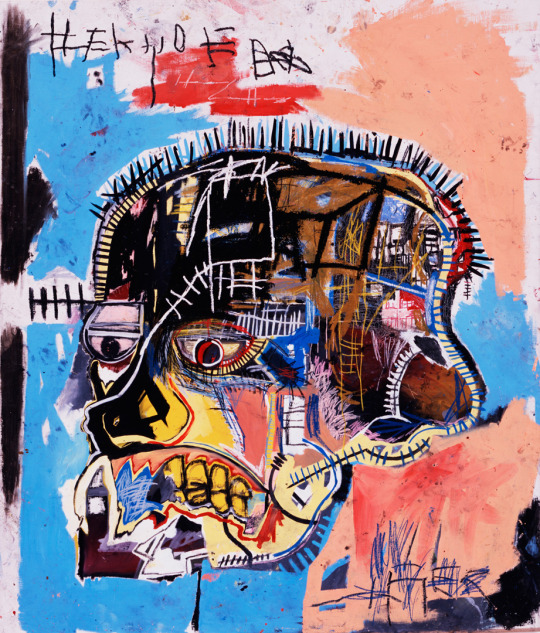
“Untitled” -1981 (acrylic and oilstick on canvas)
We viewed another work by Basquiat in this lecture despite viewing a similar piece of the same name 2 lectures prior, I was not disappointed though as stated before I am a huge fan of Basquiat’s work. In this untitled piece we see a human head, half-way between the points of life and death as can be seen by the early stages of decomposition on the subject's face. As with many of Basquiat’s work this piece is in some way autobiographical, symbolising the hardships he faced growing up in a heavily white orientated world. The face appears to be lobotomised, possibly symbolising the American school system brainwashing the youth of the country into believing that only through patriotism will they be accepted whilst neglecting crucial parts of black history. The sheer intensity of the piece can be felt through the explosive use of colour with many seemingly random placed details composing the misshapen head.
Faith Ringgold

“Tar Beach 2″ -1990 (silkscreen on silk)
Faith Ringgold was an African American artist whose work captured the dreams and hopes of a young African American girl. Her piece is inspired by Ringgold’s own memories of her childhood growing up in Harlem, with fantastical elements mixed in. “Tar Beach” represented how Ringgold’s family were unable to afford to go out of town to go on holiday due to the systemic handicap that African American people had at the time in New York. Because of this her family had to be experimental when it came to leisure activities, the term “Tar Beach” represents how Ringgold felt relegated to man-made environments, often finding herself taking trips to the roofs of the many skyscrapers that inhabited the city. The people flying in the night sky represent a feeling of heroic freedom, with the power of flight giving one person the ability to go wherever they please. Ringgold’s work helps depict what life was like growing up in areas such as Harlem and can help show people the beauty that can be found within all cultures, and all economic backgrounds.
Emma Amos

“Sandy and Her Husband” -1973 (oil on canvas)
Emma Amos made countless paintings, prints and textiles that explored the themes of African American identity and culture over a span of six decades. Amos was the only female member of the Spiral Movement and was also massively involved in second wave feminism, showing the public that feminism was no longer just an issue of middle class white female artists not receiving proper recognition, but in fact women as a whole were being neglected especially women of colour. Her piece “Sandy and Her Husband” shows us Amos’ affinity for warm colours and patterned textiles as can be seen by the design of the pillows and rug. On the wall of the room behind the dancing couple is a depiction of Amos herself, portrayed in a style similar to her earlier works appearing far more abstract. From doing so Amos asserts her place within the piece, even going as far as to make direct eye contact with the viewer's gaze despite being unseen by the two aforementioned figures.
In conclusion I thoroughly enjoyed this lecture as it opened my ideas to the true theme of criticality as I found myself questioning why it was oftentime people with vast amounts of money who decided the artistic historical canon. I found myself angered that the art world was heavily dominated by a single demographic of people, finding it hard to believe that such incompetence and bigotted ideologies were present within the expressionist medium. However, a diverse mix of different cultures and backgrounds helped grace the artistic world with new, exciting pieces. An influx of wealthy curators and patrons coupled with the discrimination certain groups of people faced led to a staggering amount of artistic expression being born from New York, and the historical context behind these artists works will forever be important when reflecting upon art history.
1 note
·
View note
Text
Artist Lecture - Katja Mater and Jessica Gysil
In this artist lecture we viewed work by Katharine Mater and Jessica Gysil, specifically their independently run magazine “Girls Like Us” and how it intends to shine a light upon the ever expanding community of women and trans people within artistic culture and activism. Gysil acts as the founder and editor of the magazine, beginning its debut in 2005, whereas Mater is part of the editorial team using their talents in visual arts to give the magazine vanguard visuals to entice it’s readers. Through “Girls Like Us” these artists are able to forge their own path for feminist legacies in arts and writing, by merging politics and pleasure the magazine is mapping out tremendous strides towards a disruption of the patriarchy. “Girls Like Us” covers a wide array of topics such as;The clubbing scene, economy, the future and family. Using personal stories to help connect the reader with the subject matter further. I enjoyed the lecture they held and found the topics presented within the magazine intriguing. Not only were the artists able to encapsulate their audience through use of pleasing visuals and interpersonal dialogue, but they also provided a safe space for artists of the LGBTQ+ community to thrive.

0 notes
Text
Art in the City Lecture 5
In my 5th Art in the City lecture we focused on Paris and the beautiful artwork the glorious city of light had to offer. We explored how the French capital inspired expressionism, the roles museums and galleries played in the fruition of artists like Braque and Pablo Picasso. We also learnt how Paris came to inspire styles such as Surrealism, looking at artists such as but not limited to; Dali, Max Ernst, Leonora Carrington and Andre Breton.
We learnt how the leading demographic of rich, white men controlled the market of historic paintings, resulting in an abundance of nude depictions of women and few men. Often idolising and romanticising the past in an futile effort to escape the woes of modern life. A brutal lack of expressive opinions were present in Paris due to the market being so heavily one sided, leaving no room for artists to truly express themselves.
Paul Gavarni

“Le Flâneur” -1842 (illustration)
Gavarni’s illustration of a ‘Flâneur‘, a French term for a person who saunters about, also meaning ‘Man of Leisure’ shows a rich painter in highly fashionable clothing. The painters would stroll about the street, having grown bored of looking to the past for inspiration for their work, instead choosing to draw muse from modern day life. The artists were beginning to object to the traditional ways and thus the sparks of an artistic revolution were born. Whilst still heavily controlled by rich, white men the galleries were beginning to showcase a much more diverse array of artistic expression.
Amaury-Duval

“Naissance de Venus” -1862 (oil on canvas)
Amaury-Duval, full name Eugène Emmanuel Amaury Pineux Duval, who first exhibited in ‘The Salon’ in 1833 with many pieces., here presents us with a depiction of the goddess Venus. His piece “Naissance de Venus' ' or in English “Birth of Venus' ' was made to encapsulate the male gaze. Venus is depicted as a nude European woman seductively posing for the viewer. When viewed whilst on display the middle eyeline is drawn towards her breasts, allowing the predominantly male viewers to objectify her with their perverse observance. Despite being a beautifully crafted piece, upon reflection of the reasoning behind it’s creation one can only shudder at the disbelief that an artwork can be controlled by one demographic's direct influence. A practice that still to this day is in use, with modern day advertisements often using sexual themes to sell a product to consumers.
Édouard Manet
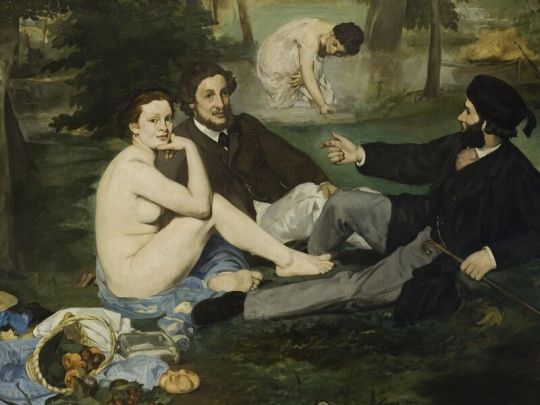
“Le Déjeuner sur l'herbe” -1862 to 1863 (oil on canvas)
When this piece was first released to the public it was met with laughter and discarded, failing to meet the standards of the aforementioned controlling demographic. The woman's gaze matching the viewers is a direct challenge to the ‘Male Gaze’ meeting it head on as if to say “Yes, I’m sitting naked eating a picnic, so what?” The woman is depicted to be naked, not nude, the difference being that when naked the depiction is one of true form, a realistic image of a human being. However when nude you are creating an idealised perversion of the female or male form, choosing to exaggerate certain features to achieve a more “desirable” outcome. The creasing in the woman's slumped posture perfectly embodies the difference between the two forms. This piece speaks volumes to the subtle change that was happening within the artistic world of Paris, with artists rebelling against the status quo and choosing to instead paint themes before thought “unfit” for showcase.

“A Bar at the Folies-Bergère” - 1882 (oil on canvas)
In the second Manet piece we viewed a disinterested woman who is presented working behind a bar at an opera house. Manet chose to not name the subject of this piece, simply portraying the woman as another commodity amongst the alluring array presented in the foreground. In the mirror behind the woman a man is shown with his gaze set upon her, showing the viewers that despite the woman possibly being a merchant she is also a thing to be purchased and owned. A theme that represented the many woman in France at the time turning to prostitution in order to make enough money to survive. “A Bar at the Folies-Bergere” comments on the disadvantages of the working class women of French society at the time, showing the viewer that despite being in a place of entertainment, this subject cannot enjoy herself, being reduced to nothing more than a commodity to the male audience.
James Abbott McNeill Whistler

“Symphony in White, No. 1: The White Girl“ - 1861–1862 (oil on canvas)
Whistler worked tirelessly day and night during the winter of 1861 to 1862 on “The White Girl.” His mistress, Joanna Hiffernan, modelled for the piece. Hiffernan was an Irish born beauty who was the subject of many other artists of the time. Despite Whistler living in Paris during the pieces creation, he painted this piece as a submission to the 1862 Royal Academy of Arts exhibition, a yearly event held in London. This event was renowned for being juried by a group of artist/academicians, who’s thoughts and ideas on the credibility of the piece were vital to distinguish success. Choosing to demonstrate his artistic prowess Whistler decided to incorporate patterns highly reminiscent of the popular Japanese art that was being traded into Paris at the time. It is evident to see that the portrayal of Hiffernan here drew inspiration from Eastern ceramic patterns that were being heavily romanticized in the upper class western world, showing the important interactions of cultures taking place at the time. As the world grew ever more advanced and more countries were able to establish trade relations, the more the artistic world had freedom to grow as it could learn from all these unique cultures.
Mary Cassatt

“In the Lodge” -1878 (oil on canvas)
Mary Cassat was an American born woman who trained as a painter in Philadelphia before travelling to study in Italy and France. By 1873 she had settled down in Paris. She soon grew tired of the conservative approach to the arts she was taught in those academies of the French capital and further accentuated by the exhibitions they were organising. Cassatt soon found her place among the Impressionists, a small independent group of French artists, where she began to freely express herself. This information is all crucial as in her piece “In the Lodge” we can see her feelings towards the toxic masculinity of the art world of the time. Cassatt is respectfully adorned in all black whilst attending a show at an opera house, she however is still subjected to the ‘Male Gaze’ as we can see an abstract man watching her through his pair of opera glasses. Whilst on display in Boston in 1878 critics described her piece as “striking” also adding that her piece “surpassed the strength of most men” This speaks volumes to Cassatt’s talent and ability to challenge the predominantly male controlled world she is a part of.
Pierre-Auguste Renoir

“Luncheon of the Boating Party” -1880-1881 (oil on canvas)
The famous piece by French Impressionist Pierre-Auguste Renoir was said to be the best painting in the Seventh Impressionist Exhibition in 1882 by three separate critics. Showing us that despite breaking away from the early impressionist interests Renoir achieved success through showing us the world through the eye of the suburban working class of the time. The subjects of the piece are all identified as good friends of the artist, a context that upon reflection can be felt through the warm, joyful tones of the piece. With the viewer’s eyeline following along the centred euphoric faces of Renoir's dear companions whilst they enjoyed lunch after a boating trip. The mingling of these French people of separate classes, shown by the juxtaposition of the men clad in suits next to the men in working glass attire, highlights the important shift of French society. As the divisions of the class were dissolving, so too could French artistic culture progress.
Berthe Morisot
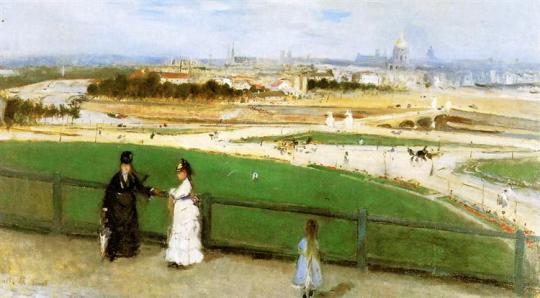
“View of Paris from the Trocadero” - 1871-1872 (oil on canvas)
In this piece from famous French painter Berthe Morisot, a prominent female member of the Impressionists, we are shown a depiction of the life of the upper class women of the time. Despite Morisot’s artistic talent, her opportunities were still limited due to her gender. In “View of Paris from the Trocadero” we see a child accompanied by two highly fashionable women, resting upon a fence overlooking a bustling city. This can be interpreted as Morisot feeling entrapped by the domestication of French wives and mothers, being confined to the gardens and houses whilst their husbands attend events such as; races, exhibitions and auctions. Despite her setbacks Morisot was still able to gain a standing within the artistic world, partly due to her friendship with Édouard Manet, however she was still not awarded the same gratification the male artists received.
Abstract and Surrealism
The lecture then turned its focus from Impressionist art to the Surrealist movement taking place within Paris, looking at artist’s such as Mary Leonora Carrington and Picasso. We explored the wide array of cultural inspirations that many of these artists had available to them, as well as learning how Surrealism grew in popularity through their work.
Picasso
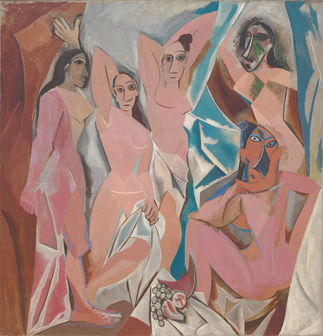
“Les Demoiselles d'Avignon” -1907 (oil on canvas)
In this abstract piece presented to us by the famous cubist painter we see five nude women seductively posing for the viewers attention. Through Picasso’s use of distortion of the female form and use of geometric shapes in an innovative way he challenges the often idealized depictions of womanly beauty. The facial proportions of these women are heavily inspired by the traditional ceremonial masks created by African tribes. Despite never alluding to the connection himself the resemblance is uncanny and it is well known that Picasso would’ve had access to these traded commodities brought from the African continent. By failing to credit the cultural influence these indigeonous people’s artistic expression had on his work, Picasso instead appropriates these ideas and passes them off as his own. Showing us that all throughout history the wealthier upper class were free to appropriate and romantise cultures different to their own, often for monetary gain, whilst neglecting the countries of origin.
Ballets Russes

“Parade” -1917 (live performance)
Parade was a ballet premiering in 1917 featuring costumes and sets designed by Pablo Picasso, taking advantage of the opportunity he was given to explore themes from his studio in a completely different setting. Parade shows us the beginning of Picasso’s shift towards a more figurative way of artistic expression, being described as “a kind of surrealism” by poet Guillaume Apollinaire three years before the movement emerged in Paris. We can see Picasso’s cubist design work within the costumes presented to us, with men made up of abstract shapes and forms just barely resembling that of the human form performing their choreography to the audience. However Picasso’s cubist designs were met with booes, hisses and nearly caused a riot before the critical audience members were drowned out by thunderous applause, showing us that not everybody in the upper class society was prepared for the change that was taking place in the art world at the time.

“Two Women Running on The Beach” - 1922 (gouache on plywood)
In this piece we see Picasso returning to the Neoclassical ways of painting, his choice to paint timeless and traditional themes were inspired by his many trips to Italy which prompted a rival in the classical motifs and subjects of the 17th century. As with many pieces during the Neoclassical movement, Picasso’s work is not identical to the classical pieces it is inspired from, in many ways challenging the “return to order” French society was experiencing post war. The piece depicts two large naked women joyfully running along the shoreline whilst holding hands. The tan, warm colours of the women are contrasted against the deep blue of the sea in the background, with the sky and sea appearing to merge with one another due to a lack of detailing. Despite the women being adorned with clothes reminiscent to those of classical origin, they are far from the idealized nude depictions of women that were popular at the time. The dresses falling off and the women's lack of care give the viewer a sense of clumsiness, showing us that these women aren’t here to attract the ‘Male Gaze’ and are instead simply enjoying themselves.
Rene Magritte

“Son of Man” - 1964 (oil on canvas)
In this self-portrait presented by Magritte we see a man dressed in a suit and bowler hat standing in front of the sea, his face however is largely obscured by an apple hovering in front of the subject. The subject's left arm appears to bend backwards at the elbow. When commissioned to paint a self portrait Magritte stated that he often found it difficult to paint his own portrait, describing his difficulties as a “problem of conscience” The apple obscuring his face was used to invoke the human desire to see what’s hidden beyond the visible, a theme Magritte often discussed, speaking of the conflict that can arise between “the visible that is hidden and the visible that is present” leaving viewers to imagine what the face looks like in its entirety. The tie between the use of the fruit and the title “Son of Man” is reminiscent of Christian ideas of the temptation of Adam and Eve within the Garden of Eden leading to the subsequent fall of mankind.
Mary Leonora Carrington
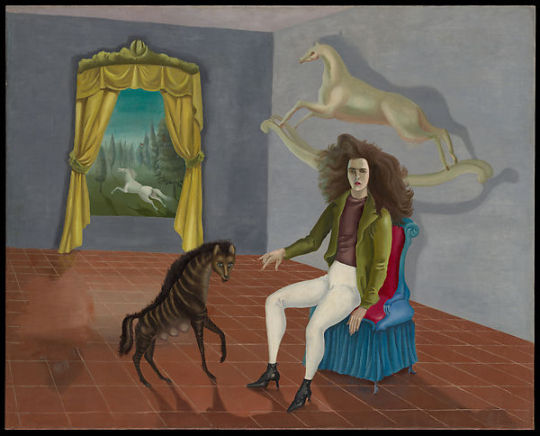
“Self-Portrait (Inn of the Dawn Horse)” -1937-1938 (oil on canvas)
Carrington was a British born Mexican artist and one of the last surviving members of the Surrealist movement. She began the self portrait in London before completing it in Paris in 1938, becoming one of her most recognized works and being coined her first truly surrealist work. In this piece we see an empty room with a tiled floor, Carrington can be seen sitting on a lavish blue chair with her hair flowing as if she were underwater. Beside her outstretched hand is a Hyena, a theme that became prevalent in a lot of her future work, possibly suggesting Carrington aligning herself with an intrusion of the wild into a domestic space. Her deep interest in Celtic mythology can be seen through her addition of horses, the horse being white in colour suggests a connection to the Celtic goddess Epona who would, according to legend, appear before her followers atop a white stead.

“The Meal of Lord Candlestick” -1938 (oil on canvas)
In this piece we see an example of Carrington merging her art with symbolism inspired from her personal life, having completed the painting shortly after escaping her former life in England to pursue an affair with Max Ernst. The figures in the piece are inspired by depictions of roman leaders, sitting around a bountiful feast gorging themselves upon the many foods laid before them. Through this symbolism we see Carrington’s rejections of the strict Roman Catholic upbring she was subjected too. The name “Lord Candlestick” was a reference to her abusive father, emphasizing her disregard for the regulations her father attempted to instil in her life. The religious symbolism in this piece is instead presented to the viewer as a visceral display of barbarity, with monstrous abstract forms feasting upon a human infant and many other creatures. This piece shows us the personal freedom Carrington was able to find within France as she purposely revokes the symbolic order of religion and maternity.
Salvador Dalí

“Apparition of Face and Fruit Dish on a Beach” -1938 (oil on canvas)
The final piece we viewed in the lecture was Dalí’s surreal piece created during one of his famous dream sequences. In this piece Dalí uses optical illusions to intentionally confuse the viewer, causing them to further examine the piece as to explore all the hidden details. An abstract face is visible upon first glance before contorting and transforming into a bowl of pears, behind which we can see a dog whose body shifts into the landscape beyond itself. This work belongs to a group of paintings Dalí had created to instantiate an optical illusion referred to as the ambiguous image. A practice that explores graphical similarities and other properties of visual interpretation of two or more distinct image forms. Dalí captures this technique beautifully with his masterful command of the surreal world of art, adapting and creating his own unique style of illusitory artwork.
In conclusion I enjoyed our lecture on the dazzling City of Light, my eyes were opened to many artists who were unheard of to me. After taking the personal time to further research the artists presented to us I found myself deriving inspiration from the Surrealism movement the most, the abstract freedom the movement seemed to present fascinated me greatly. I believe that both the Impressionist and Surrealism movements were monumental steps within the art world toward a future free of controlling demographics and confirmative ideals.
0 notes
Text
Artist Lecture - Emily Speed
In my third artist lecture we looked at Emily Speed, a Liverpool based artist, born in Chester. Her work seeks to merge the relationship between buildings and the human form, she explores the relationship between the body and architecture. Exploring the ways the buildings that surround us can shape the people that occupy them and how a person occupies their own psychological space. She was also shortlisted for Liverpool and North West Art Awards and has been commissioned pieces such as ‘Flatland’ for the Tate in Liverpool.

Her piece “Innards” , a fountain featuring a live performance, took over a year to build, constructed from hand-made and hand-glazed tiles. Water, architecture, gardening and intimacy are homogenized together to reference important elements of the women’s lives who were impacted by the Knole House in Kent.
1 note
·
View note
Text
Art in the City Lecture 4
In my fourth art history lecture we celebrated black history by taking a look at renowned black artists and their work. We explored the prejudices they faced in the earlier years of artistic history and the unjust treatment they endured throughout these times, along with the fantastic artwork these factors birthed.
Jean-Michel Basquiat

“Untitled” -1982 (acrylic, spray paint and oilstick on canvas)
Born in New York Basquiat led a rebellious lifestyle, spending most of his time spray painting graffiti on the streets and subways where he grew up. His art is loud, aggressive and exploding with colour. Each piece assaulting the viewers eyes with harsh brush strokes forming abstract figures, often autobiographical in nature. Basquiat deeply detested the appropriation of African tribal masks in artworks of those such as Picasso, who recreate the facial proportions thought of by these indiginous people whilst passing it off as their own design. The calculations that can be seen above the skull is meant to represent the money that was accumulated during the slave trade. I adore this piece and have been a long time fan of Basquiat’s work also admiring his pieces “In This Case” -1983 and “Riding with Death” -1988. His ability to capture the anarchistic idea of rebellion whilst portaiting the unethical treatment of his people is outstanding.
Kevin Beasley

“Hammer Projects” -2017 (sculpture)
Inspired by a baroque altarpiece in Saint Peter’s Basilica and an infamous image of Black Panther Huey P. Newton, the gold, lavish sun rays accentuate the piece tenfold. Using a mixture of African tribal shields and cotton based fabrics he transforms an originally christian piece into a memorial for the freedom fighter, who was tragically killed by law enforcement. His piece evokes a sense of mourning, yet also a lingering flame of passion, showing the viewers that although Newton may have passed on his dream still remains within this world.
Donald Rodney

“In The House of my Father”-1996 to 1997 (photograph)
In this piece by British artist Donald Rodney we see a simplistic house held together with needles, however the most intriguing part of this piece is that the material used to craft the house are Rodney’s skin removed during one of the many operations he underwent to combat sickle cell anaemia, an inherited disease that affects people of African, Caribbean, Eastern Mediterranean, Middle Eastern and Asian ancestry. This represents the pain Rodney feels for not being able to be at his fathers side at the time of his death, due to himself being in hospital at the time. I would also like to comment on how this piece is unframed, an interesting choice as an unframed piece does not contain the world within the art work, allowing the viewers to interpret the piece in a multitude of separate ways.
Sokari Douglas Camp

“Blind Love and Grace” - 2016 (sculpture)
Camp’s own interpretation of a section of a painting by Botticelli, a sculpture made of oil barrels depicting an African woman standing clad in renaissance style clothing, holding up her right hand in a direct parody of Venus. Atop the woman a blindfolded cupid can be seen wielding a bow and arrow, a metaphor that coined the name “Blind Love” The most curious aspect of this piece is despite the materials used being heavy and cumbersome, Camp manages to achieve a delicate look to her piece. The mystic beauty of her creation breathes an aura of life into these otherwise discarded objects, able to create beauty out of the otherwise ‘useless’ objects.
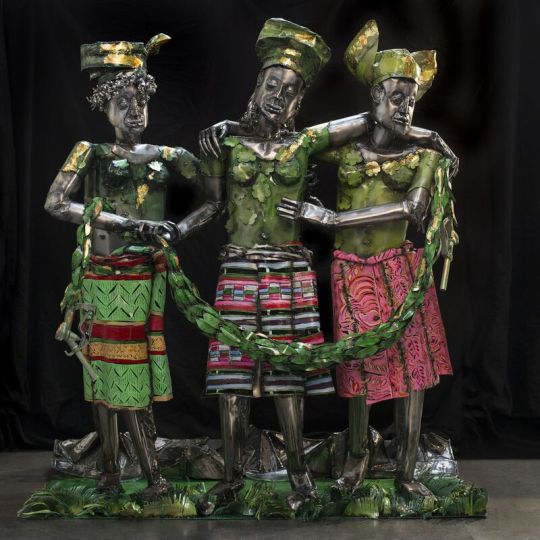
“Europe Supported by Africa and America” -2015 (sculpture)
In the next one of Camp’s pieces we examined her sculpture depicting a European woman being held up by an African and native American woman, inspired from William Blake’s piece of the same name. The three women representing the titular continents are all holding a comforting embrace, supporting one another despite Europe's past discrepancies against the other two continents. The piece is once again made up of oil cans and petrol pumps, these objects were used to symbolise the western world's constant oil drilling within Africa. The draining of Africa’s natural resources for nothing more than capitalist greed has left the continent in a state of corruption and impoverishment. Not to mention the lasting effects this has had on the environment, making agriculture a difficult task and leaving many villages to go hungry. Camp’s work enlightens us on these pressing issues through a lens of beauty.
Theaster Gates

“Amalgram” -2020 (exhibition)
The exhibition presented the history of the island of Malaga, a post up for the slave trade that eventually became a rich cultural haven for multiple races living together. In 1912, on the orders of the state governor, Malaga's inhabitants were forcibly made to leave the mainland. They were offered no housing, jobs or support. Gates’ exhibition ranges from sculptures to film to question the ideas of race, territory and inequality, especially within the United States. The blues and gospel recordings of The Black Monks could be heard echoing throughout the forest of sculptures, creating a powerful feeling of immersion as Gates thrusts you into this detailed rich history.
Zanele Muholi

“Zanele Muholi: Somnyama Ngonyama, Hail the Dark Lioness” -2019 (photographs)
Muholi is a transgender activist from Johannesburg, their work encapsulates the everyday lives of the LGBT+ community within South Africa and she has been doing so for over a decade.They once stated that their mission is "to re-write a black queer and trans visual history of South Africa for the world to know of our resistance and existence at the height of hate crimes in SA and beyond." For each image in her collection she adorns herself with objects within her immediate vicinity, taking each portrait in a separate location including clothespins, cowrie shells and washing machine tubes. Using their own body to tackle the heavy themes of representation within today's society, Muholi questions the way in which the black form is represented in modern media; they chose to exaggerate the darkness of their skin tone in an effort to “reclaim their blackness.”
Wangechi Mutu

“Histology of the different classes of uterine tumors” -2004 to 2005 (mixed media)
In the final piece we examined Mutu’s mockery of a calendar made for the objectification of the female form, using the parody to simultaneously comment on the lack of medical care given to African women specific diseases. In doing so she collectively explores the absurd contradictions of female and cultural identity in relation to colonial history, African politics and Western commodification. By fusing cut out body parts from various magazines and books Mutu constructs a visage of uncanny faces, provoking a feeling of unease upon first glance. She doesn’t idolise the women in her work as her work was not made for the perpetuation of the ‘Male Gaze’ and instead chose to speak about themes close to her heart.
In conclusion our lecture was extremely informative and eye opening, not only broadening my mind to many new artists of colour but also opening my eyes to the unjust prejudices that minorities in the western world will face. Whilst we as a planet have made strides towards a more equal future the end is still far from sight with racism still far too alive in the western world.
0 notes
Text
Artist Lecture - Janis Rafaildou
Janis Rafaildou is a Greek born film director with a PhD in Fine Arts from the University of Leeds. Using film to present her experiences and feelings. In the year 2009 she found her interests slowly creeping toward the macabre, themes of death and use of lifelike props of deceased animals became ever present in her work.

Her short film “Gravediggers” (2019) is a 30 minute long film Rafailidou created showing two men bearing an uncanny resemblance to her father travelling and collecting the remains of dead animals to be prepared for burial. The depictions of the animal corpses were so real in fact that it caused outrage within my class with one student even threatening to boycott the artist before learning that the corpses were merely props. I think this scenario speaks volumes on the effect Rafailidou’s work is able to invoke, showing a human's imperfect quickness to judge upon first glance, not giving the art the time it deserves based on an initial assumption. She has done similar work where she depicts a couple collecting dead pets for cremation, and upon completion returning the ashes to the previous owners. Her ability to balance on the line of beauty and death, showing the beauty within death itself and embracing the macabre theme resonated with me as I have always had a deep rooted fascination with the concept myself.

In her work “8 Kilos of Garden” Rafailidou dug up eight kilos of her parents garden, in which the remains of previously deceased pets her father had buried can be seen. Whilst disturbing to some, the beauty of the skeletal form left after the flesh and muscle have rotted away brought me joy. For when we all return to the earth all that remains is the structural supports that held us together during life. These remains should be treasured, holding almost sacred energy within them and the memories they represent.
0 notes
Text
Artist Lecture - Nick Bastis
For our first Wednesday online artist lecture we were studying Nick Bastis, an American born artist specialising in human geography and architectural studies. After dropping out of college and moving to Chicago he chose to lead a happier life working in a school, helping the students with sculpture work.

Bastis’ work ‘clock’ (pictured above) is a calling card he often reuses in his pieces. More often than not it is placed in areas of the room that are untouched by light, creating a mysterious aura about the piece and creating a sense of bitter loneliness. He has also created multiple video works which mix audios, clips and subtitles together to a piece that is not bound by the conventional methods of filming and editing. This further expands upon Bastis’ vision to create artwork that harmonises differently through this use of his unique style. Bastis chooses not to promote his work on social media, which I find odd yet inspiring, the mystery surrounding his pieces is further accentuated by his online footprint being so little.
Another tutor group was assigned to ask questions to the artist to attempt to give the class a deeper understanding of Bastis’ work and his reasoning throughout the creation of his pieces. A fellow student asked “What is it like to collaborate with other artists?” to which Bastis replied “I find coming up with ideas and concepts much easier, as each artist is able to come up with their own interpretations which allows the ideas to seem more unique.” To which I agree, whenever I have worked with multiple artists on a single piece I find the planning stage often moves a lot quicker than when I am left to my own devices.
0 notes
Text
Art In The City Lecture 3
In our third Art in the City lecture we focused on London and the many advantages that the capital city gained with its diverse melting pot of cultures. We examined groups such as the “YBA” an acronym for Young British Artists and their rise to popularity and lasting success.
JMW Tuner
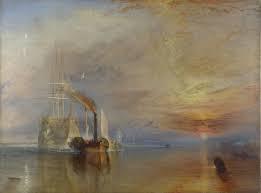
“The Fighting Temeraire”-1838 (oil on canvas)
Turner was one of the first artists to paint ‘Plein air” a French term for painting outdoors, a technique adopted by many pre raphaelites. This resonated with me as my nan would often paint outdoors in her cottage in France, despite being english herself she speaks French fluently and has spent a lot of time depicting beautiful watercolour pieces of the French landscape.
Richard Hamilton

“Just what is it that makes today's homes so different, so appealing?”-1956 (collage)
This piece is considered the birth of pop art, the collage shows a contemporary Adam and Eve surrounded by the temptations of modern post war consumerism. The piece paradies American capitalistic greed, cramming a small room with cutouts of films, new technology and food. This speaks true even today with consumerism at an all time high with countless families purchasing items that are non essential to simply living. The effect over marketing these products has had on the world is devastating, with many countries being seen as “impoverished” for simply not being able to afford a TV, when in reality those countries are often poor and neglected due to western capitalist greed.
Lucian Freud

“Benefits Supervisor Sleeping” ‘Portrait of “Big Sue” Tilley’-1995 (oil on canvas)
This portrait Freud presents us with a naked woman laying on a sofa, he perfectly captures all the imperfections of the subject's skin, creating a perfect unidolised depiction of the woman. Tilley is shown as a normal woman, not a nude painting of a goddess to draw attention from the straight male audience, instead she is lying comfortably on a sofa showing all her naked form. This piece was clearly made without the ‘Male Gaze’ in mind, choosing to instead capture the life in front of him in all it’s realistic glory.
Frank Auerbach

“Head of William Feaver” -Ongoing (oil on canvas)
In this piece we see Auerbach’s visceral, expressionistic portrait of William Feaver, a famous British art critic. Auerbach was a jewish boy born in Germany in 1943, he was shortly moved to London never to see his family again. His heart breaking pain can be felt through his heavy meaningful brush strokes, and choosing to constantly update the piece from 2003 onwards layering thick heavy lines of paint and then carving away at the hardened remains to repeat the process again. His dedication to his work is awe inspiring and speaks volumes on the destruction brought about by the Nazi party in the second world war, standing as a testiment as to how we as a united planet cannot let devastation of that magnitude to happen again.

“Study after Titian II” -1965 (oil on canvas)
Both this piece and another of a similar title are inspired by Titian, a famous Venetian painter during the Renaissance, and his piece “Tarquin and Lucretia” a depiction of an early Roman tale of the sexual assualt of a woman and her subsiquent suicide. Auerbach created his own interpretation of the piece by having a female model adopt the pose of Lucretia, and another from a drawing made from a reproduction of the original work. In both works Auerbachs empathy for the woman's pain can be felt with the harsh violent brush work almost violating the canvas itself.
Damien Hirst

“The Physical Impossibility of Death in the Mind of Someone Living”
In this famous piece Hirst suspends a deceased shark within a cuboid container of formaldehyde, shocking the first viewers of the “Freeze” exhibition. Having always been a fan of Hirst’s work I was delighted to see him in one of my lectures. The use of a corpse for artistic purposes fascinates me greatly and Hirst’s work takes the grotesque and makes it beautiful. Once the “YBAs” rose to fame many areas of East London became gentrified and commoditized, losing the original charm the once culturally rich area held.
Tracey Emin

“Everyone I Have Ever Slept With 1963–1995″ -1995 (embroidered tent)
In this controversial piece Emin presents a tent with an embroidered centre, the walls of the tent are adorned with names of people who Emin claims to of ‘slept with’ however she cleverly takes a more literal approach choosing to add in the names of her mother, father, childhood friends and even her old stuffed animals. This piece was made to comment on the male stereotype that a woman who proudly shows off the amount of people she’s ‘slept with’ as ‘imperfect’ whilst not holding themselves to the same rules. The controversy spawned by the name of this piece among the male viewers who simply didn’t take the time to further analyse the piece and learn it’s true meaning amuses me greatly.
Marcus Harvey
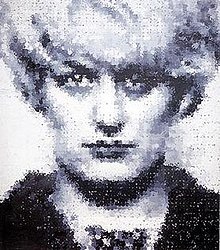
“Myra” -1995 (infant handprint painting)
This depiction of the serial killer Myra Hindley, one of the Moors murders responsible for the sexual assaults and murders of 5 children aged 10-17, the large black and white portrait of her famous mugshot was made using multiple handprints of children to construct a rendering of the evil woman. The controversy this piece brought about was unrivaled, with multiple protesters attempting to vandalise the piece, resulting in Harvey selling the piece to his agent. Whilst I agree that one person should never profit off the death of others I also believe that one should be free to express any artistic vision they may have. Perhaps if Harvey hadn’t sought financial gain this piece would have a different history.
Chris Ofili
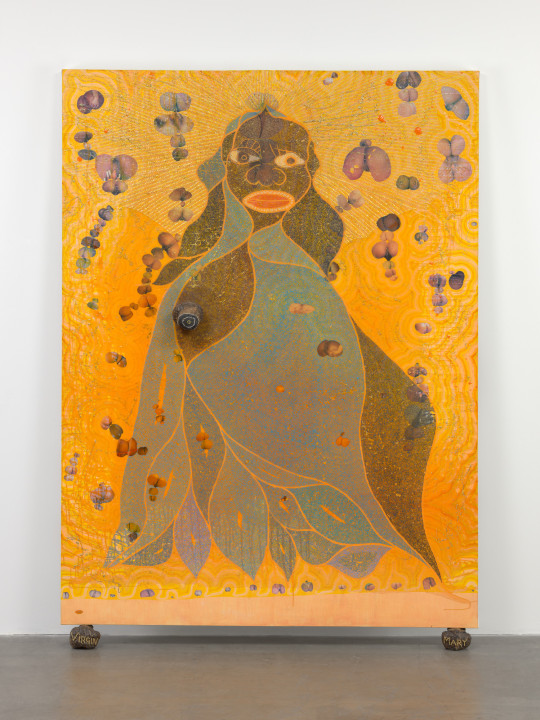
“The Holy Virgin Mary” -1996 (mixed media)
Ofili presents his depiction of the Virgin Mary adorned in a blue dress, parted to expose a single breast to represent fertility. Mary is depicted as an African/Middle Eastern woman, clashing with the racist westernisation and white washing of biblical characters despite their setting being the middle east. Mayor Rudolph Giuliani’s predisposed Christian prejudistic mindset was outraged by such a piece, withdrawing 7 million from the city hall grant for the museum and threatening eviction in a pathetic attempt to have the piece removed. However the museum resisted keeping the piece up in celebration of Ofili’s work. The piece is protected by a layer of plexiglass to help prevent vandalisation of the work. I find the religious outcry towards this piece as disgusting as it is hypocritical, for was it not the western world that robbed people of colour of their culture and identity, painting it white and calling it their own. The depiction of biblical figures as perfect beautiful white people is nothing more than to keep the heavily xenophobic western world under christianities fingertips.
Sarah Lucas

“Au Naturel“ -1994 (’ready-made’ 3D piece)
A slumped over mattress is adorned with objects representing the male and female genitalia, the sexual undertones of the piece are contrasted by the dirty unwashed mattress invoking a feeling of disgust and repulsion. This piece adverts the ‘Male Gaze’ instead choosing to be raw and unforgiving.
Jenny Saville

“Plan” -1993 (oil on canvas)
Savillie once said “I paint flesh because I’m human. Flesh is just the most beautiful thing to paint.” Her work portraits naked women and the transgender community through her heavy viceral brush strokes almost allowing the paint to become like skin itself. Her studying of liposuccion and the markings made on a woman's body when deciding where the surgery would be performed seemed scary to her back then, however she has gone on to comment on how in today's modern western world there’s barely anyone who doesn’t at least know what the surgery is. Her work helps confront the struggles people face and her use of beautiful imagery to do so is inspiring.
In conclusion this lecture allowed me to observe and study many different and intriguing artists, my personal favourite work presented in the lecture being that of Frank Auerbach, his depictions of pain and use of heavy abstract brush work fascinated me, spurring a passion to research more into his work. Exploring new mediums and the controversies one can face when entering the art world broadened my mind, allowing me to move forward and tackle future artistic endeavors with ease.
0 notes
Photo



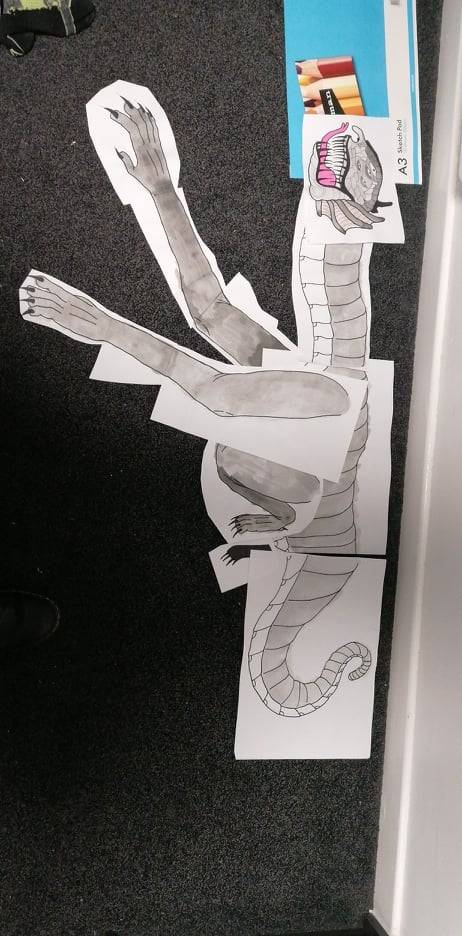

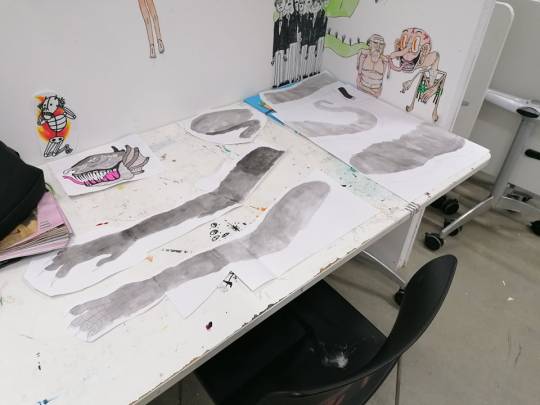
“POWER” Personally Set Task
Whilst I had time before my next assignment was set I decided to set myself a task, I wanted to create a piece to do with the theme of power, after brainstorming ideas that could represent the mighty and powerful I landed on the idea of creating a large dragon to soar through the skies of the world I was creating. After realising that I wanted to create one of these elusive beasts of mythology I began sketching down ideas. To connect my piece with common depictions of dragons I added many snake-like characteristics like a forked tongue and a long serpentine neck. By using reference from real world creatures such as lizards and snakes I was able to create a more realistic looking dragon, something that would’ve been able to evolve in the realms of possibility. I knew I wanted my creation to be gargantuan in comparison to the previous pieces I had made so I opted to make each of the beast's body parts on a separate piece of A3 paper. Once I had sketched out and drawn the pieces of my creation I got to work recreating this monster on a larger scale.
Using watercolours and POSCA pens I added colour to the beast, choosing to go for a dark colour pallet. My reasoning for doing so was that oftentimes in mythology black dragons are harbingers of death and destruction, powerful creatures that intoxicate those around them with dread. I wanted my piece to also embody these old characteristics, and to give off a sinister aura upon viewing. Adding in hints of crimson red to compliment the heavy blacks also worked towards the creature's alluring aesthetic, allowing the fleshy tones to stand out against the inky scales. Once each piece was fully coloured I began the painstakingly long procedure of carefully cutting out each piece of the monster and running through assemblage ideas before committing to a final composition. Once happy with the position of the beast I stuck each piece together to assemble the full monstrosity. I then adorned the wall of my studio workspace with the hulking goliath, positioning them above all of the previously created works. Overall I am beyond amazed with how this piece turned out, it is easily one of my favourite pieces I had created in this cartoonish style. The sheer size of this creature almost demands the viewer's attention upon first glance, the dark tones against the white walls drawing our gaze towards it. The powerful aura created by the size difference between this piece and my previous works beautifully compliment each other, allowing each piece to flow seamlessly between one another as one large coherent art piece.
-”The Ghoul”
0 notes
Photo


“FUTURE” (Eyes) Mini Degree Task
After choosing the word “eyes” from the list of prompts provided for the future task I began researching surveillance, CCTV specifically, I watched countless conspiracy videos to fuel my creativity and landed on the idea of being controlled by those that watch us. I wanted to show this idea in a physical form and began sketching up ideas for my piece. I knew I wanted whatever I drew to have a security camera for a head, and I opted to have a giant red human eyeball inside of the lens, allowing me to represent two separate ways of the fear of being watched. Drawing inspiration from the absurd conspiracy theory that all birds are actually government cameras, I wanted my creature to fly, allowing these “watchers” to cover more ground. Further perpetuating the metaphor that we are being watched by unstoppable forces. I chose to give the creatures a malnourished human body with insect-like wings, my reasoning for doing so was because I believe manipulation of the human form is one of the most intriguing types of horror. The reconstruction and crudely designed depictions of a body we are so familiar with can trigger a primal reaction of unease due to our brains recognising a figure enough to make out it is attempting to appear human whilst able to see that it is not.
After reconstructing my finished design on a larger scale I chose to have three separate entities as opposed to my previous idea of there being a single watcher. I chose to do so to further drive in the feeling of helplessness against these physical embodiments of the feeling of being watched. Using a mixture of watercolour paints and POSCA pens I gave my piece colour, choosing to make the creature's bodies pale and withered. I then cut the pieces out and placed them onto my wall, situating them near to the sun I had previously created. My reasoning for doing so was because much like the story of Icarus, the powers that are in positions able to watch and track the working classes movement are in turn, flying too close to the sun. Because with the rising popularity of more left wing ideologies in the modern day generations, the actions of those previously in power are now being questioned and challenged.
-”The Ghoul”
0 notes
Photo
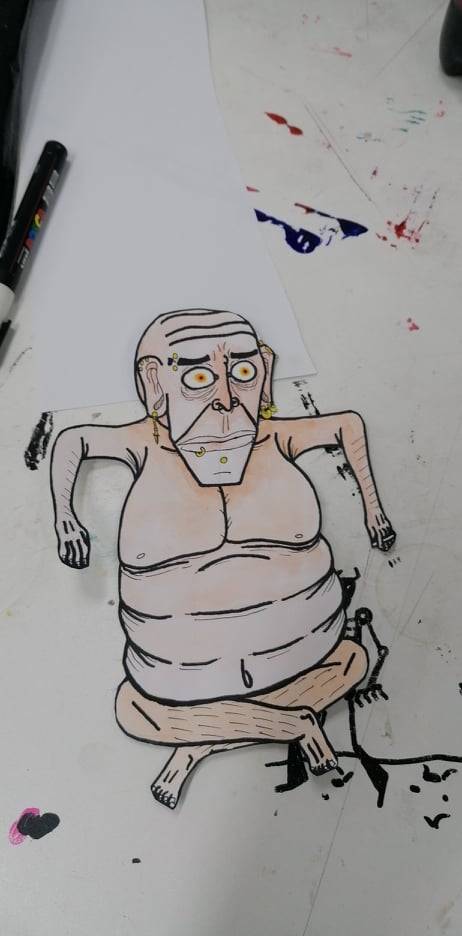


“SUCCESS” Mini Degree Task
Upon discovery that the next assignment I had to complete was to be a successful version of my previous “FAILURE” piece I began pondering ideas for how I could redeem the failing aspects of my former work. My initial idea was to draw a realistic human being to contrast the cartoonish aesthetic of my previous work, however for continuity's sake I decided to keep the former aesthetic going to further add to the overall feel of my conjoined pieces. Instead I opted to drastically morph the qualities I had exaggerated in my failure piece to the opposite end of the scale. In doing so I would represent the idea of unearned success, attributing the idea to a scenario I thought of. In said scenario the task is to mop a floor and make sure every area is covered with soap, however in a fit of anger you kick the mop bucket spilling the water everywhere, technically you have got soap onto every surface just not in the intended way.
So I sketched up a concept of a character that could be related to my failure piece but the exact opposite. I drew a large plump body to counter the skinny proportions I previously used, also choosing to shrink down the limbs, hands and feet. Once happy with my concept I recreated my idea on a larger scale and placed him next to my failure piece. Once in position I was able to view the two pieces next to one another and began to think that once my success piece was next to the previous work it started to look a lot more proportionate than before. Furthering my initial idea of unearned success, for when my cartoonish, still largely exaggerated piece was next to the previous work it began to look like a more successful depiction of a man. Although neither pieces show truly accurate realistic depictions of a human being, one is still more recognisable whilst the other rests within the uncanny valley causing the mind to feel more reassured about the less exaggerated piece, despite itself not being a true depiction of reality.
-”The Ghoul”
0 notes
